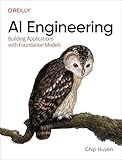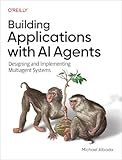Best AI Development Tools to Buy in December 2025

AI Engineering: Building Applications with Foundation Models



Building Applications with AI Agents: Designing and Implementing Multiagent Systems



The Best AI Tools for Designers: How to Supercharge Your Creativity with AI - For Brand, Graphic & Motion Designers



Developing AI Applications: Beginner-Friendly Guide to Building AI Solutions from Scratch with No-Code Tools (Rheinwerk Computing)



Generative AI Design Patterns: Solutions to Common Challenges When Building GenAI Agents and Applications



Expert in Everything: How to Keep Your Job & Thrive in the Age of AI



Kaisi Professional Electronics Opening Pry Tool Repair Kit with Metal Spudger Non-Abrasive Nylon Spudgers and Anti-Static Tweezers for Cellphone iPhone Laptops Tablets and More, 20 Piece
- COMPLETE 20-PIECE KIT: TOOLS FOR ALL YOUR ELECTRONICS REPAIR NEEDS!
- DURABLE STAINLESS STEEL: PROFESSIONAL-GRADE TOOLS FOR REPEATED USE.
- BONUS CLEANING TOOLS: KEEP SCREENS SPOTLESS AFTER EVERY REPAIR!



AI-Assisted Coding: A Practical Guide to Boosting Software Development with ChatGPT, GitHub Copilot, Ollama, Aider, and Beyond (Rheinwerk Computing)


To define a neural network architecture in PyTorch, you can follow these steps:
- Import the necessary libraries: import torch import torch.nn as nn
- Define a class for your neural network by subclassing the nn.Module class: class YourModel(nn.Module):
- Inside the class, define the constructor method __init__(): def __init__(self): super(YourModel, self).__init__() # Define the layers and parameters of your network here
- Within the __init__() method, define the layers and parameters of your network using the available modules in nn: self.layer1 = nn.Linear(input_size, hidden_size) self.activation = nn.ReLU() self.layer2 = nn.Linear(hidden_size, output_size) Here, nn.Linear() represents a fully connected layer, nn.ReLU() is the activation function, and input_size, hidden_size, output_size are the dimensions of your network.
- Define the forward pass method forward() in your class. This method describes how the data flows through your network: def forward(self, x): x = self.layer1(x) x = self.activation(x) x = self.layer2(x) return x Here, x represents the input to your network.
- That's it! Your neural network architecture is defined. You can now create an instance of your model and use it for training or inference: model = YourModel() You can also move the model to a GPU if available: device = torch.device("cuda" if torch.cuda.is_available() else "cpu") model.to(device)
This is a basic outline of how to define a neural network architecture in PyTorch. You can modify it based on your specific requirements by adding more layers, changing activation functions, or any other necessary adjustments.
What is the role of batch normalization in a neural network?
Batch normalization is a technique used in neural networks to improve the training process and the overall performance of the model. Its main role is to normalize the intermediate activations of the network by adjusting and scaling the inputs.
Here are the key roles of batch normalization in a neural network:
- Normalization: Batch normalization normalizes the input data by standardizing it to have zero mean and unit variance. It achieves this by subtracting the batch mean and dividing by the batch standard deviation.
- Reducing internal covariate shift: The internal covariate shift refers to the change in the distribution of network activations due to updates in the previous layer's parameters during the training process. Batch normalization reduces this shift by maintaining a stable distribution of inputs for each layer throughout the training, which accelerates the convergence.
- Regularization: Batch normalization acts as a form of regularization as it adds a small amount of noise to the network due to the mini-batch statistics used for normalization. This noise reduces overfitting and improves generalization.
- Accelerating training: Batch normalization allows higher learning rates and faster convergence of the network. By normalizing the inputs, it helps in avoiding saturation of activation functions and enables the network to learn more quickly.
- Handling different batch sizes: Batch normalization is effective even when using different batch sizes during training and inference. This flexibility makes it easier to train models on different hardware and platforms.
Overall, batch normalization helps in stabilizing and accelerating the training process, allowing the neural network to learn more effectively and generalize better.
How to start building a neural network architecture in PyTorch?
To start building a neural network architecture in PyTorch, you need to follow these steps:
- Import the required libraries: Import the necessary libraries such as torch and torch.nn.
- Define your neural network architecture: Create a class that inherits from the torch.nn.Module class. This class will serve as your neural network architecture. Inside this class, define the layers of your neural network in the __init__ method and the forward pass logic in the forward method.
- Define the layers: In the __init__ method of your class, define the layers of your neural network using the available modules from torch.nn. For example, you can use linear layers (torch.nn.Linear), convolutional layers (torch.nn.Conv2d), recurrent layers (torch.nn.LSTM), etc.
- Implement the forward pass: In the forward method of your class, specify how the input data passes through the defined layers. You can apply activation functions (torch.nn.ReLU, torch.nn.Sigmoid, etc.), pooling operations (torch.nn.MaxPool2d, torch.nn.AvgPool2d), or any other required operations.
- Initialize an instance of your network: Create an instance of your defined network architecture by calling the class you created.
Here's a simple example of building a feedforward neural network architecture using PyTorch:
import torch import torch.nn as nn
class NeuralNetwork(nn.Module): def __init__(self, input_dim, hidden_dim, output_dim): super(NeuralNetwork, self).__init__()
self.fc1 = nn.Linear(input\_dim, hidden\_dim)
self.relu = nn.ReLU()
self.fc2 = nn.Linear(hidden\_dim, output\_dim)
def forward(self, x):
out = self.fc1(x)
out = self.relu(out)
out = self.fc2(out)
return out
Example usage
input_dim = 10 hidden_dim = 20 output_dim = 5
model = NeuralNetwork(input_dim, hidden_dim, output_dim)
This example creates a simple feedforward neural network with two fully connected layers. The input dimension is 10, hidden dimension is 20, and output dimension is 5.
How to choose the appropriate stride for a convolutional layer?
Choosing the appropriate stride for a convolutional layer can depend on several factors such as the input size, output size, task at hand, and computational constraints. Here are some considerations to help you choose the appropriate stride:
- Input and Output Size: Determine the desired output size of the convolutional layer. A larger stride will reduce the size of the output feature map, while a smaller stride will preserve more spatial information. Consider the balance between downsampling and preserving information based on the task requirements.
- Object Scale and Spatial Awareness: Consider the scale and complexity of objects or features you want your convolutional layer to detect. If you expect small or densely packed features, a smaller stride may be more appropriate to capture those details. On the other hand, larger strides can be suitable for detecting bigger and simpler objects.
- Computational Efficiency: Larger strides reduce the number of computations required, resulting in faster training and inference times. If computational resources are limited or speed is a priority, using a larger stride might be beneficial. However, be cautious not to compromise too much on accuracy by using a very large stride.
- Network Architecture: The stride choice should align with the overall architecture of your neural network. Convolutional layers are often stacked, and the choice of stride may influence subsequent layers and their receptive fields. Ensure consistency in stride across related layers to maintain a coherent hierarchical representation of the input.
- Experimental Evaluation: Experiment and compare different stride values during model training and evaluation. Monitor metrics like accuracy, performance, and computational resources to assess the impact of the stride on your specific task and dataset.
- Transfer Learning: If you are using pre-trained models or approaches, examine the stride choices made in the original model and evaluate whether they align with your task requirements.
Remember, the optimal stride value will vary depending on your specific problem, dataset, and available resources. Hence, it is essential to experiment and evaluate different stride values to find the most suitable one.
How to choose the appropriate activation function for a neural network?
Choosing the appropriate activation function for a neural network depends on various factors, such as the type of problem you are solving, the nature of your data, and the architecture of your network. Here are some considerations to help you make a choice:
- Non-linearity: Activation functions introduce non-linearities into the network, allowing it to learn complex patterns. Ensure that the activation function you choose is capable of modeling non-linear relationships.
- Gradient vanishing/exploding: This refers to the tendency of gradients to either diminish or explode during backpropagation. To avoid gradients becoming too small or too large, select activation functions that can alleviate this issue, such as ReLU (Rectified Linear Unit) variants.
- Range of output: The output range of the activation function should match the requirements of your problem. For example, sigmoid and tanh produce outputs between 0 and 1, whereas ReLU produces values greater than or equal to zero.
- Sparsity: Some activation functions, like ReLU, introduce sparsity by only activating a subset of neurons. This can be beneficial in certain scenarios, such as when dealing with high-dimensional data.
- Smoothness: If you need a smooth activation function that is continuously differentiable, options like sigmoid and tanh can be suitable choices.
- Computational efficiency: Some activation functions have more computationally efficient implementations, leading to faster training and inference times. For example, ReLU is computationally cheaper than sigmoid or tanh.
- Experimental results: Depending on the specific problem domain, certain activation functions may have been found to perform well in similar tasks. It is useful to refer to existing literature or experiment with various activation functions to find the best fit.
It is worth noting that different activation functions can be used in different layers of your neural network, allowing for more flexibility and improved performance.
What is the concept of stride in convolutional layers?
In convolutional layers, stride is a concept that determines the step size for the filter/kernel during the sliding/window operation across the input image. It refers to the number of pixels that the filter moves in each direction horizontally (width) and vertically (height).
Typically, a stride of 1 is used, meaning the filter moves one pixel at a time, resulting in a dense overlapping of the receptive fields. This helps capture more spatial information and enables precise localization of features in the input.
However, by increasing the stride, the filter skips pixels and leads to a reduction in the spatial dimensions of the output volume. For example, with a stride of 2, the filter moves two pixels at a time, resulting in a halved output size in both width and height.
By adjusting the stride, convolutional layers can control the downsampling or "shrinking" of the spatial dimensions, which can be useful in reducing computational requirements and overfitting, as well as extracting higher-level features by capturing larger receptive fields. However, it may also result in a loss of spatial information if the stride is too large.
